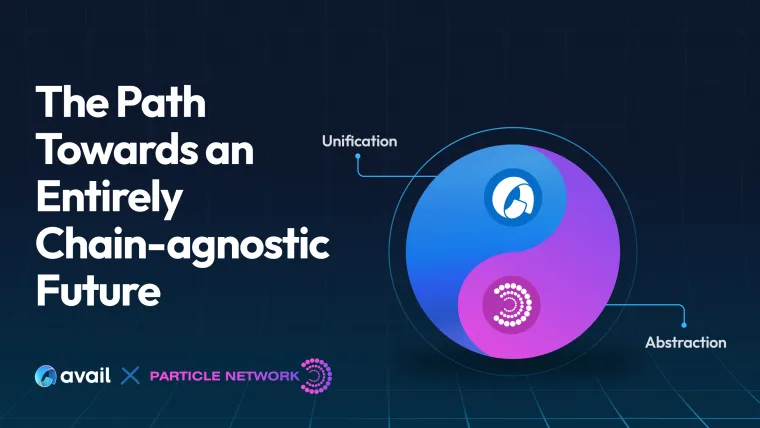Paradoxically, an ideal blockchain ecosystem is one where users don't even notice the existence of blockchains.
Chain abstraction (ChA) has emerged as a movement to simplify Web3’s user experience to a point where different manual processes (such as handling multiple gas tokens, bridging, etc.) are removed. The vision of ChA, as such, is a world where users are unaware of the chains they’re using. Achieving this does not require a single technology—but rather, an assembly of different components working in-sync.
This article will focus on:
- Account-level chain-abstraction solutions, such as Particle Network’s Universal Accounts
- Blockchain-level unification, such as Avail Nexus
What do we mean when we talk about abstraction and unification?
There are three levels of chain abstraction:
- The application level: coordinates the ability of applications to span multiple chains, creating chain-agnostic experiences.
- The account level: abstracts the interactions between users and their accounts, facilitating an experience where users have a unified balance across every blockchain they use.
- The blockchain level: unifies the experience of interacting with multiple chains, often part of the same stack, with intrinsic compatibility.
Abstraction and unification, to a great degree, enable the experience of ChA for users. Meanwhile, the application level is mostly developer-focused.
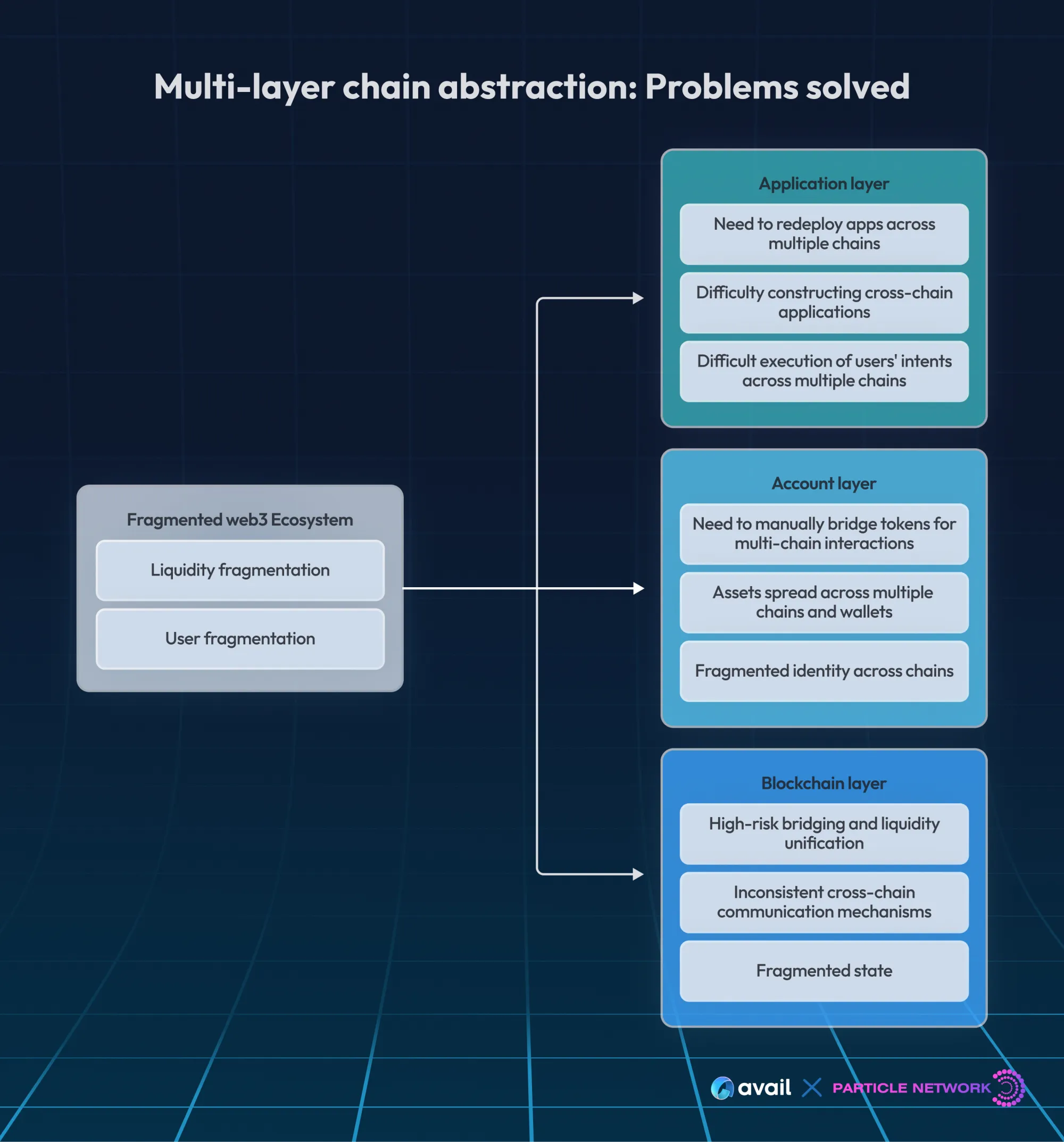
Since unification tackles fragmentation from an infrastructural perspective, it allows blockchains to be fundamentally interoperable with one another. This results in the ability to execute trust-minimized atomic cross-chain transactions. This makes unification the ideal state of the blockchains. As such, its execution mostly takes place within clusters, such as Polygon’s AggLayer, Optimism’s Superchain, and zkSync’s Elastic chain ecosystem.
Meanwhile, the necessity for tools that can realize the ChA vision wherever unification can’t has given birth to abstraction. Abstraction spares users from directly interacting with the infrastructure—blockchains, in this case—powering the applications they use. It doesn’t aim to directly make chains interoperable, but rather simplifies the experience of using applications in a fragmented ecosystem… ideally one that’s as unified as possible.
Next, we’ll zoom into two examples, one for each category, to then take a step back and analyze the ChA ecosystem at large.
Avail Nexus and Particle Network
Avail Nexus is a unification solution, optimizing interoperability at the blockchain level, whereas Particle Network addresses chain abstraction through its Universal Accounts at the account-level.
Here’s how each of them, in their own level of the stack, enables chain abstraction:
Nexus, rollup cluster, and how it enables ChA
In essence, Avail Nexus is a ZK (Zero Knowledge) coordination rollup on top of Avail. The major functions of Nexus are proof aggregation and verification, and it will also implement a sequencer selection mechanism. Because Avail Nexus uses proof aggregation, it verifies the state of all the chains which are interacting with it. Nexus aims to enable this cross-chain communication and event passing among 100s of connected chains.
Currently, Avail Nexus works with zkRUs (Zero Knowledge Rollups) where validity proofs are generated and all of them are submitted by different chains. These different validity proofs are then aggregated and a single, concise proof of these validations is produced.
To understand it more, let’s look at an example:
- There are two appchains: NFT chain and Balances chain.
- Alice lists her Pudgy Penguin NFT for sale on the NFT chain.
- Bob wants to buy it but has native assets on another chain, and his network configs on his wallet are also set up for the Balance chain. Bob still goes ahead and clicks Buy.
- At this point, Bob could execute the transaction from either the NFT chain or Balance chain's UI.
- Once the payment is processed, Bob is redirected to the NFT appchain with a new, shiny NFT from Alice.
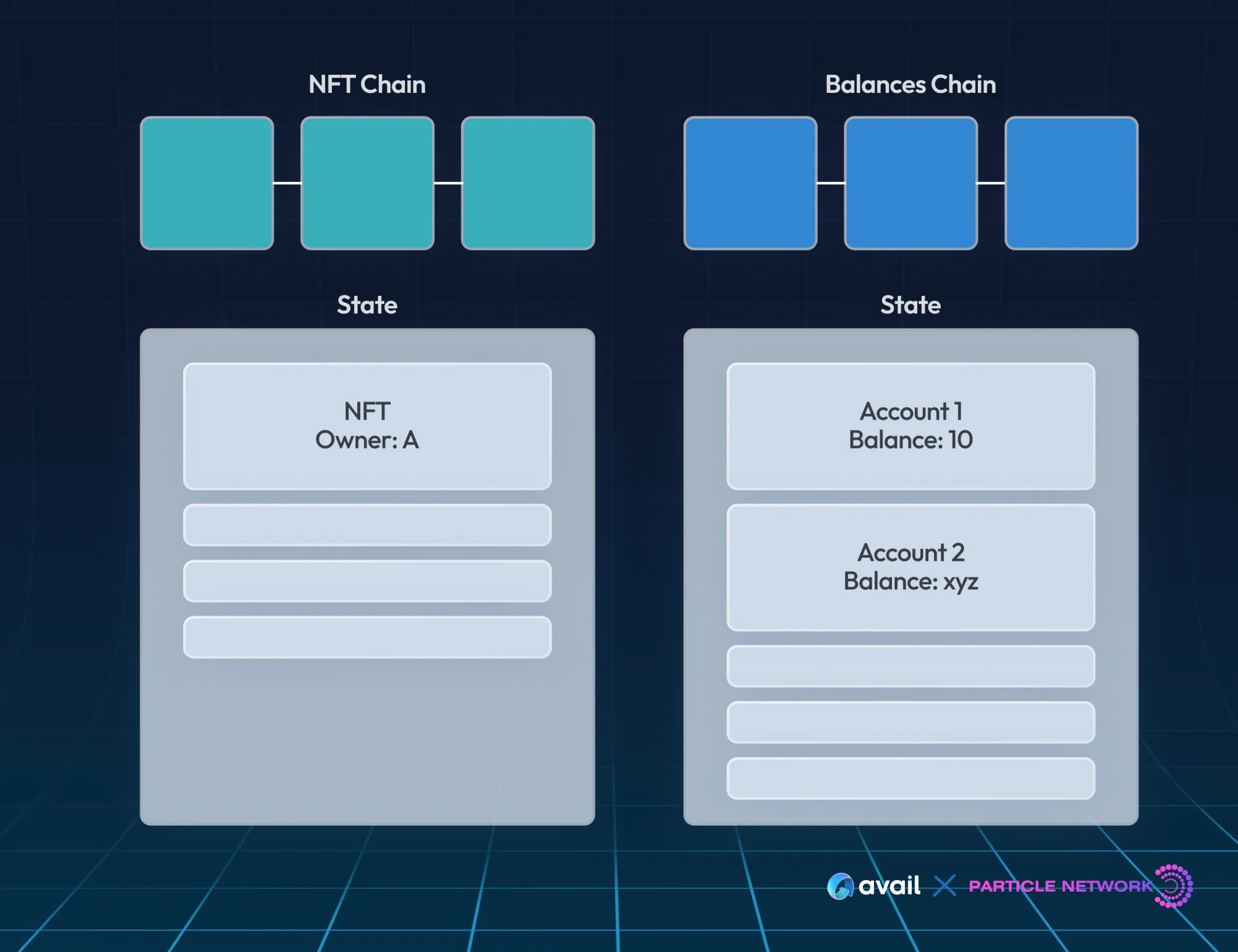
The diagram above shows two chains as in our example above. But when a new state is triggered, e.g., to buy the NFT, the state in the first chain should change to pending.
This is very similar to Stripe’s payments process where user A buys online stuff from a merchant, and is redirected towards a Stripe page, pays, and then gets redirected to a “successful payment and buy order ” page. This is what’s happening in the background with Nexus as well.In more technical terms, the state changes of the NFT chain and Balances chain generate proofs which are later verified and aggregated by Nexus’ proof aggregation system. Using this mechanism, Bob has a proof of the payment made, sends the txn proof to the NFT chain and gets the NFT transferred to his wallet based on that proof.
The diagram below shows how it works between the chains and Nexus.
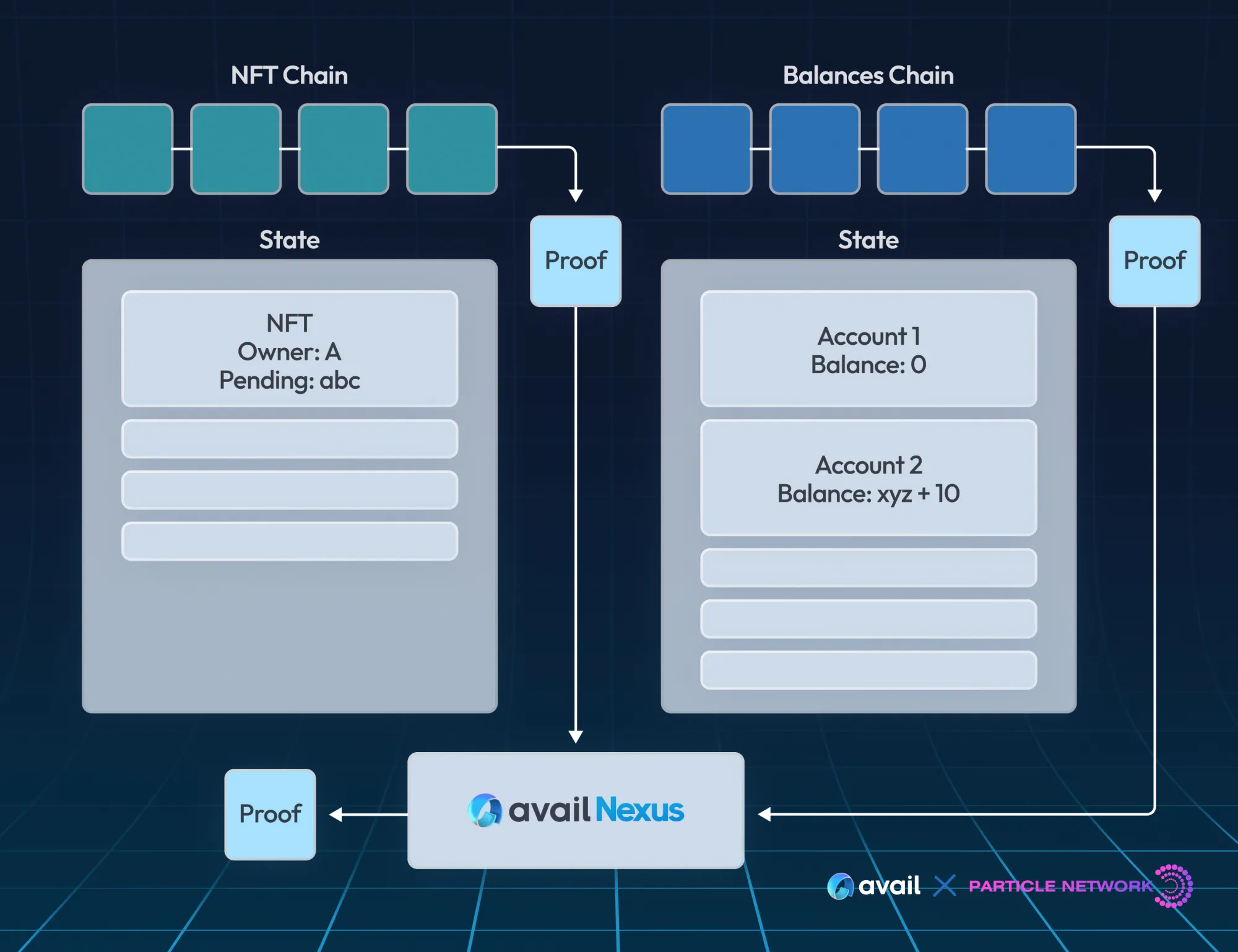
Particle Network and Universal Accounts
Particle Network achieves chain abstraction through Universal Accounts (“One account, one balance, any chain”). UAs provide users with a unified balance, which can be used to interact with any blockchain or their dApps, paying for gas in any token.
To a user, this may look as follows:
- Alice has 100 USDC distributed across 5 chains—$20 in Ethereum, $20 in Solana, and so on for Blast, Arbitrum, and Optimism.
- She finds a dApp she likes on Base. Within it, she wants to buy an NFT for $99.
- She hits “buy”. She selects the option to pay for gas in USDC.
- Universal Accounts’ underlying mechanism, Universal Liquidity, coordinates all the necessary transactions and swaps required to execute both the gas payment and to pay for the NFT on Base.
From a technical standpoint, Universal Accounts rely on Smart Account deployments on every chain, including non-EVM ones (like Solana). Users’ accounts are coordinated by the Particle Network L1 blockchain, which unifies their balances and coordinates Universal Liquidity, thanks to the programmability of Smart Accounts.
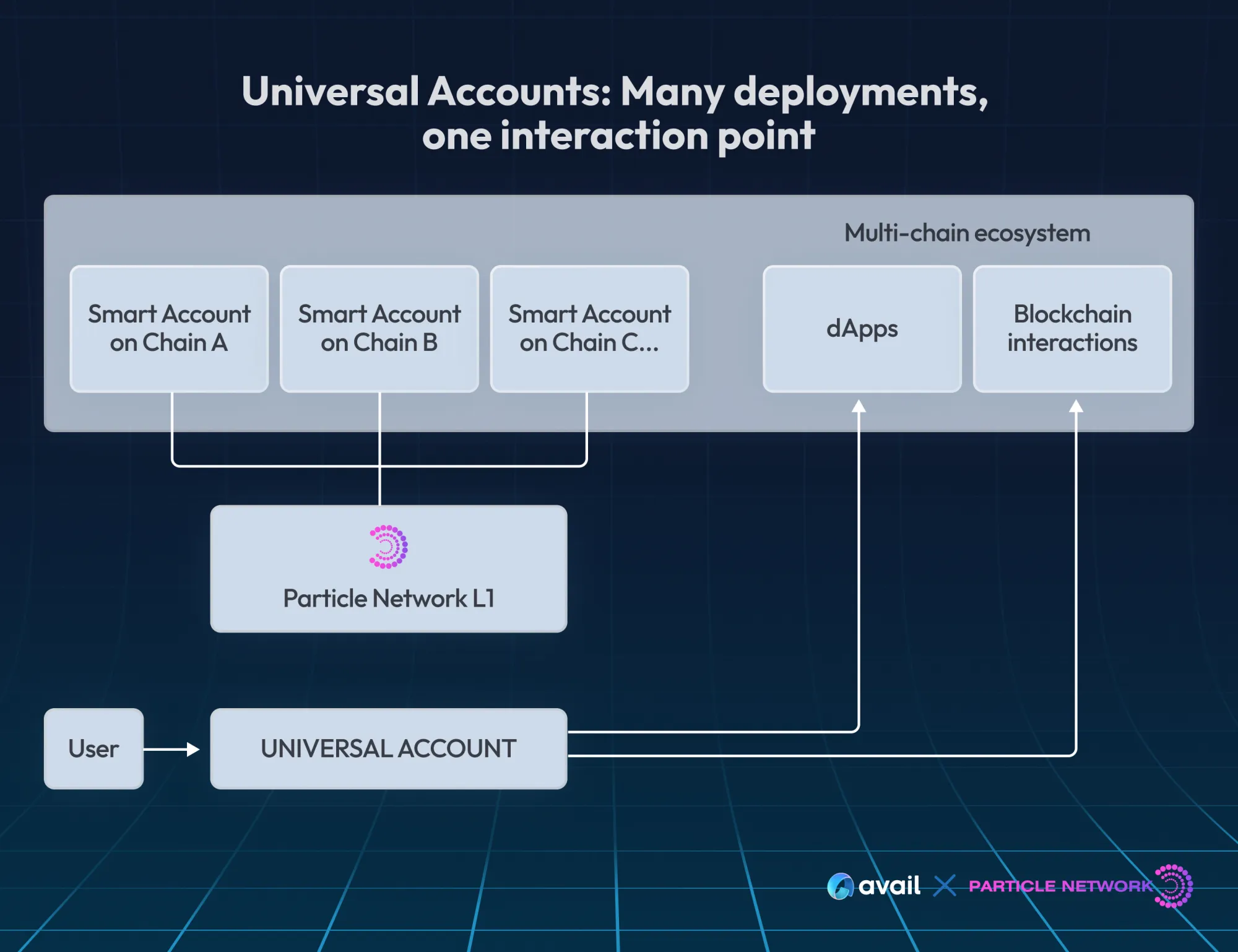
Furthermore, Universal Liquidity takes a solver-based approach to settle transactions across chains on a per-request basis, also leveraging native DEXs on each chain. Thanks to this, users can perceive their tokens as if they existed on all chains at once, facilitating a truly borderless experience.
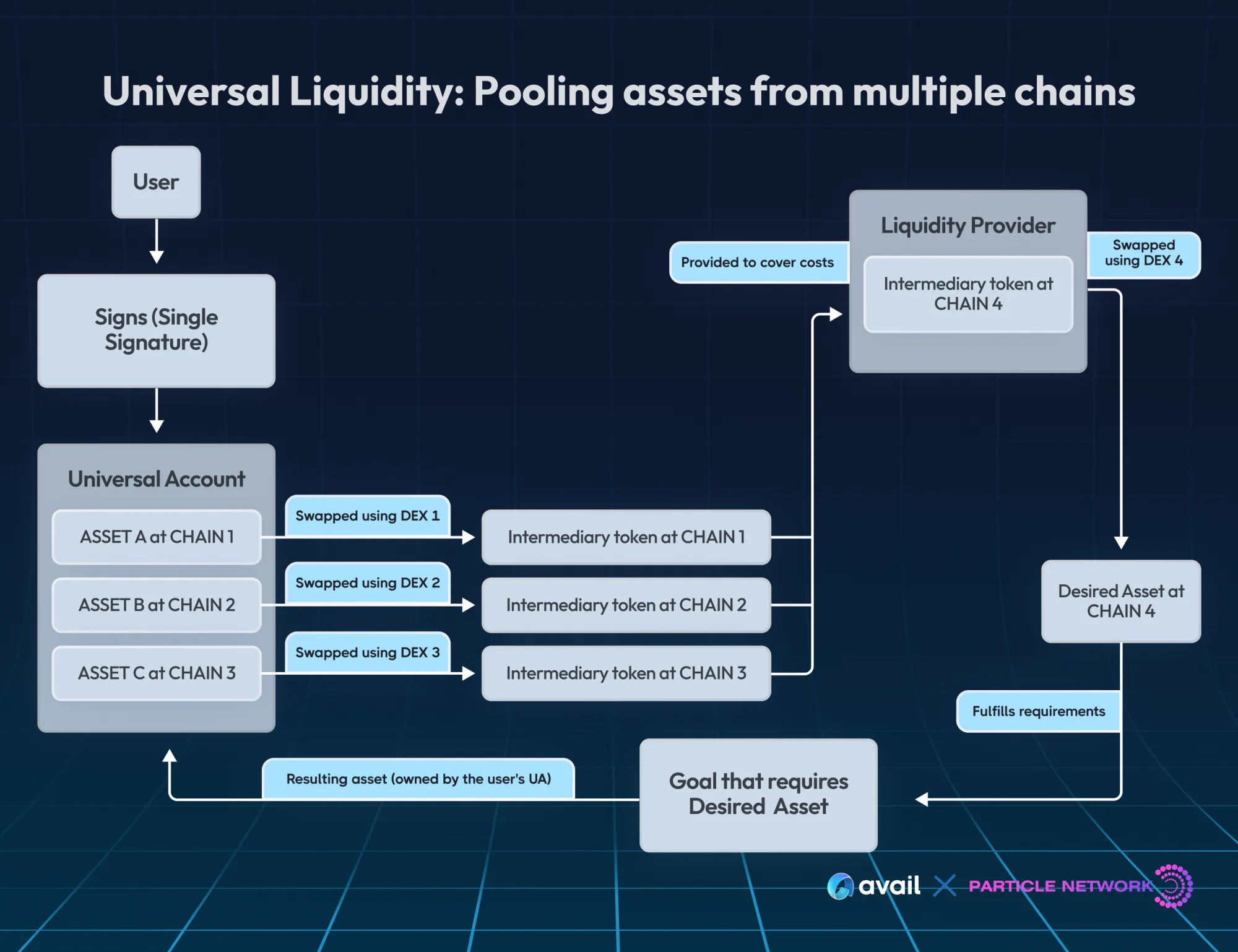
Why are unification and abstraction needed?
The number of L2s being launched into the market is increasing and it doesn’t look like it will slow down anytime soon. The Ethereum roadmap itself complements the L2 strategy. However, challenges arise when there are multiple L2 clusters.
The idea of L2 clusters is a powerful one. You can have multiple chains launched on any stack. For example, you can have ZKsync’s Elastic chains or Optimism’s Superchain; however, the full benefits of blockchains will be realized when all of these clusters connect and work seamlessly together.
Currently, it feels like we may have moved 5 steps forward, but 3 steps backward. Kinda amusing. But this also brings in the need for abstraction. Avail Nexus helps on a chain level. Along with working on zkRUs, there is also an active POC to work with optimistic chains as well and integrate with the superchain cluster. So this means the best chain abstraction scenario would be when Alice will be able to send her NFT on Zora to Bob, when Bob tries to pay from his ETH on zksync’s elastic chain, without bridging or changing networks. That will be true chain abstraction.
So, how can abstraction and unification work together?
From a user-facing perspective, an ecosystem-wide implementation of chain abstraction will emerge from the synergy between unification and abstraction solutions. For example, when it comes to Avail Nexus and Universal Accounts working together, you’ll have the former providing scalable, unified infrastructure that can support thousands of chains natively, while the latter simplifies the overall experience of interacting with ecosystems and their dApps.
This two-pronged approach is represented below:
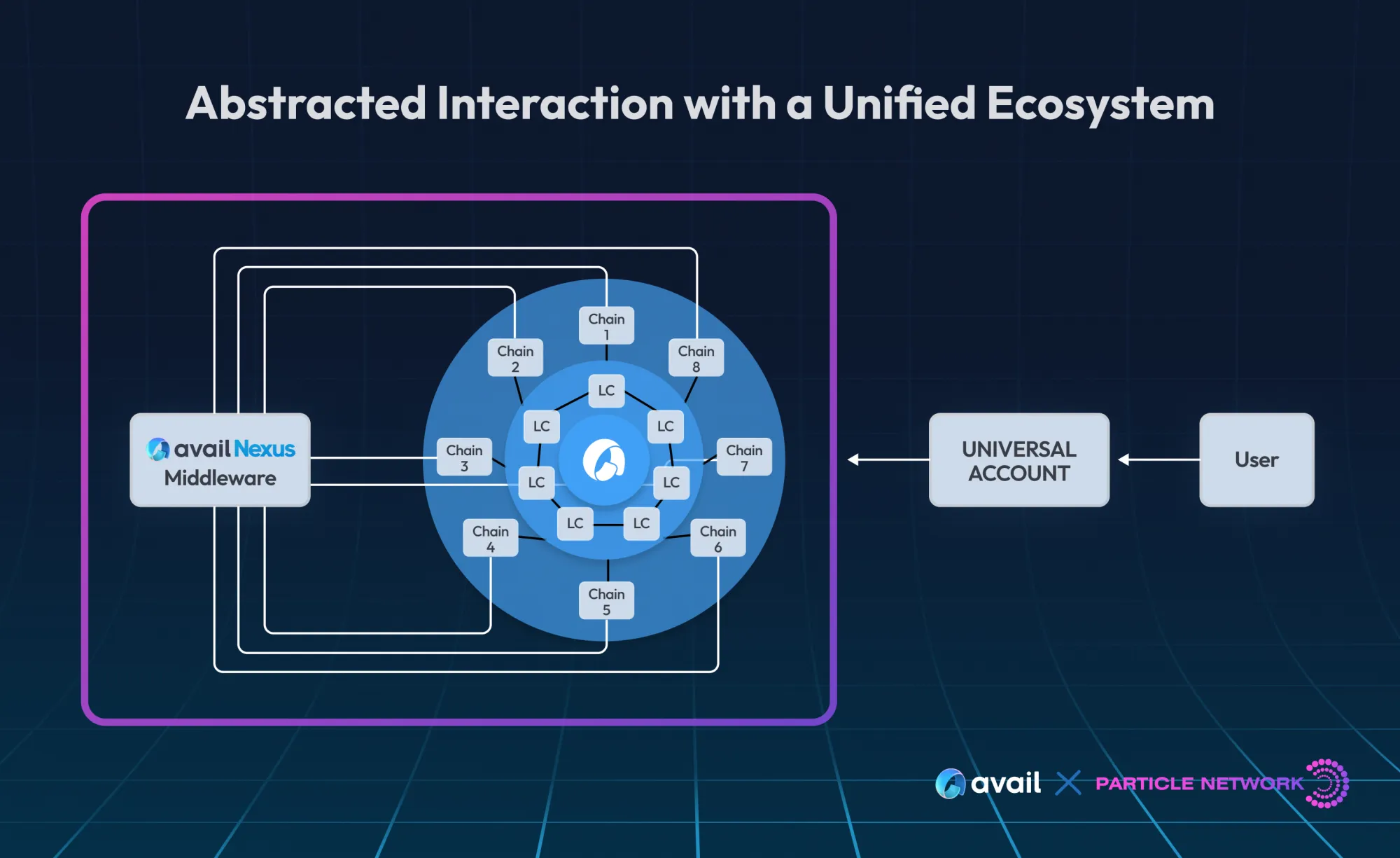
In the context of our examples, it is possible to achieve this because Nexus is permissionless and chain agnostic. This means that Nexus doesn’t care what altvm or altDA you are using or if that chain explicitly uses Avail Nexus or not. If there is an adapter to be plugged in for a certain L2 cluster with regard to Nexus, then any chain on top of that L2 cluster can submit states and interact with Nexus.
This also complements the idea of Universal Accounts. Once Particle and Nexus are live together, Universal Accounts users will be able to enjoy a seamless front-end experience, while unification ensures the back-end can scale efficiently without losing compatibility. As such, these act as complimentary, not competing solutions within the vertical of chain abstraction.
The necessity for both unification and abstraction stems, of course, from the inherent complexity of a multi-chain ecosystem. Unification solutions address the fundamental infrastructure challenges by creating inherent interoperability, while abstraction solutions like Universal Accounts tackle the user experience layer by simplifying interactions across unified networks. Without abstraction, unification would still leave users to navigate technical complexities on their own, while abstraction without unification would be merely a patch to hide Web3’s inherent fragmentation problem.
This symbiotic relationship is particularly crucial as the blockchain landscape continues to expand. Unification provides the foundational infrastructure that makes cross-chain interactions technically feasible and efficient, while abstraction builds upon this foundation to create intuitive interfaces that shield users from the underlying complexity. Together, they create a solution that addresses both the technical and experiential aspects of chain abstraction, making Web3 accessible to mainstream users while maintaining the benefits of a decentralized ecosystem.
Why should you care about ChA if it is an invisible infra?
As abstraction and unification technologies launch and mature in the span of the next few months, the ecosystem needs to embrace building with abstraction in mind from the start. This means developing applications that leverage both unified accounts and scalable infrastructure, treating them as fundamental building blocks rather than optional features. The end goal is clear: a Web3 where users can interact with any application across any chain, powered by infrastructure that makes the underlying complexities invisible.
So that begs the question, what apps would you build if users and apps were all connected? How does that shift not only what’s possible, but what makes sense from an application builder’s point of view? It may be time for application specific chains to play a dominant role in the evolution of web3, just as microservices have played a key role in the evolution of web2.
Particle and Avail are extremely bullish on this invisible infra and are in an active development stage to push the boundaries of ChA so that users can interact and transact crypto how they would do it for Venmo, Zelle or UPI.

